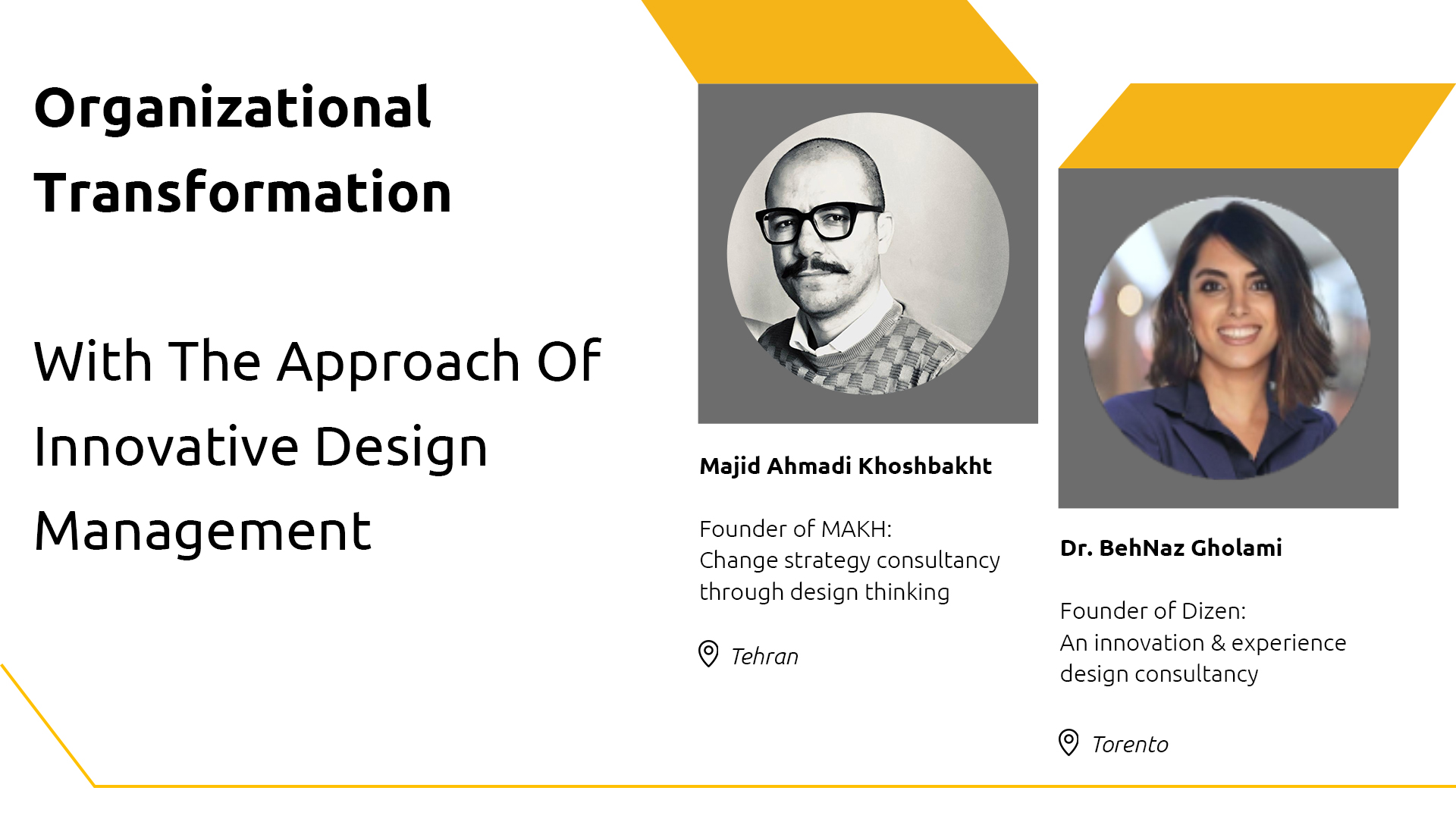

In this live interview with Dr. BehNaz Gholami, we talked about organizational transformation and the factors influencing it.
BehNaz Gholami, with 15 years of experience in consulting and research, is the founder of Dizen group which is an innovation and experience design consultancy.
+ Tell us about organizational transformation.
Basically, what does this concept refer to?
When a consulting team enters a company to create organizational transformation, what process should they follow?
+ The word transformation itself has a state of graduality.
If you Google the word transformation, you will see most results are about worms cocooning and gradually turning into butterflies.
“Gradually changing into something else” is important in transformation.
In change management, we have three types of organizational change:
1) Enhancement: This kind of change creates improvement in the organization.
These minor changes do not significantly affect people’s working lives.
2) Incremental change: Step-by-step changes that together make a big difference.
Every step alone may not be impressive, but the sum of these small changes together will eventually create fundamental changes.
3) Transformation: The whole ecosystem changes. The transformation process is very complex.
Transformation is a gradual change in which the steps of change are not easily separable and they work together in a complex system that leads to fundamental changes in the organization.
For example, changing organizational culture is a kind of transformation.
+ Great! Let’s talk more practically.
If a client comes to you asking for organizational transformation, what factors do you consider to assess whether the change is fundamentally applicable to the organization or not?
Sometimes there are very good strategies for change, but because the organization is not ready to change, the strategy may fail.
What factors do we need to consider to make sure that the change strategy works for the organization?
+ This is an interesting question. We can approach this issue from two perspectives.
The first is from the perspective of design thinking, and the second is from the traditional perspective of change management.
There is a process called “readiness assessment” for evaluating if the organization, infrastructure, costs, and human factors of the organization are ready for change or not.
We have the tools and techniques to see how ready each organization is for change and what risks the organizations may face.
Examining the organization’s readiness from a design thinking perspective and a human-centered design approach goes back to the empathy phase in the design thinking process.
This process is more practical and functional than the traditional change management process.
Because in the empathy phase, we focus on human aspects of the situation, and change is essentially dependent on human factors.
In the traditional approach to change management, the organization is often surprised although we have the “readiness assessment” questionnaire results.
Some points are missed in this traditional method, but in empathy, we can easily address these points as well.
In the design thinking approach, instead of focusing on historical data and previous statistics, we go deep into the organization.
Moreover, see who is involved in the change, what risks and resistances there are, and we measure the readiness of each group of people to change.
This process is a combination of empathy and readiness assessment which works best in combination.
+ So in fact there are two paths.
One is the traditional approach to change management, and the other is the design thinking process for creating change.
Let’s talk a little bit about KPIs.
How do you define key performance indicators that can show the business managers the changes and their impacts?
There is always this challenge that it is difficult for managers and CEOs to invest in something ambiguous.
That’s why having several key performance indicators that tangibly show the effect of change in the organization can be very helpful.
+ This is one of the old challenges in change management.
There is much debate about how the success or failure of a change management process in an organization can be evaluated.
Having a little bit of data that we can present to the client in the form of a graph or chart is very helpful and important.
Especially in traditional change management approaches.
Sometimes the CEOs define high-level measurement criteria that cannot easily be translated into the low levels of the organization that are changing direction.
For example, suppose an organization manager considers a set of metrics to measure the success of the change.
But when we bring these metrics to the operational sections of the organization, no one can relate to them and they seem pointless.
Now let’s get back to the design thinking approach.
Design thinking through empathy makes key performance indicators translatable.
Besides, tangible for operational levels of the organization and all stakeholders.
For example, in the process of empathy, I examine people’s problems. How can we make people’s lives better?
In this process, some stakeholders’ pain points are identified. Psychologically, human beings first seek to reduce suffering and then seek to improve.
In this way, we can explain to people how a series of new behaviors and changes can reduce their pain points.
After this process, we examine how these low-level changes can achieve high-level management goals.
An organizational designer is constantly translating metrics between the top and bottom levels.
At each stage, we can even count how many of the groups’ pain points have been resolved.
So we are able to turn qualitative data into quantitative graphs.
+ Thank you for your full explanation.
The question that arises here is how can we convince CEOs and change sponsors.
Sometimes it takes time to see the results of the changes made and sometimes we can not see the tangible effect in a short period?
For example, many times the changes we make at the senior management level have an impact on the lower levels of the organization which reveals itself over time.
+ This is one of the biggest challenges in change management. Most businesses are looking to see the impact of change right away.
For example, most organizations seek to adapt to the post-corona era.
But we should remind them that resilience is not something that happens overnight.
Sometimes it takes even more than a year to achieve such a goal.
Some organizations are not yet mature enough to embrace the long-term effects of organizational transformation.
I advise all people who manage change through design thinking to evaluate whether the organization is capable of accepting the process before starting the transformation.
The results must be transparent and tangible to the organization.
Most businesses want to see the broad results of change in the short term.
One of the things that design thinking emphasizes is celebrating small wins.
Let’s go back to the example of organizations’ resilience for the post-Corona era:
In such projects, after six months, we can assess whether the training of individuals has been useful for communication skills, conflict management, constructive interaction, and so on.
Interestingly, the measurement of these indicators, e.g. improving teamwork, time management, and constructive interaction, is mainly possible from the lower levels of the organization.
These seemingly small achievements are then reflected at the top levels of the organization.
The task of an organizational designer is to translate the achievements of the lower levels of the organization to the higher levels of management.
I need to mention that according to the theory of accumulation, we cannot achieve big changes without celebrating small wins.
+ You talked about the readiness of the business owner for applying the change strategy.
How do you think we can measure the CEOs’ readiness for organizational transformation?
+ In traditional change management, there are tools and questionnaires by which we measure change sponsors or CEOs.
This traditional method ultimately gives them yellow, red, or green labels according to the results of the questionnaire.
Each of which indicates their level of readiness for change.
But this is a little bit different from the design thinking approach.
The same empathy phase done with low-level stakeholders should be repeated with change sponsors and business owners.
Questions and conversations that focus more on their role as human beings than on the role of individuals in the organization.
Random daily conversations and discussions also help a lot to create a better understanding of business owners.
Another source for understanding business owners is to review the questionnaires.
Additionally, annual internal evaluations of companies and match them to the outputs of the empathy phase.
This way, we can measure the organizational culture and the organization’s readiness for change.
Sometimes it even happens that the whole organization is not ready for change.
But some influential people in the organization are receptive to change.
In this case, we can still hope to implement a change strategy for the organization.
But for some organizations, implementing innovative methods of change management does not work at all and we have to use more traditional methods.
+ Well said! Now suppose we have done the initial research and come to the conclusion that the organization is ready to implement the change strategy.
Do you think it is more appropriate and efficient to bring change to the organization from high levels such as managers?
Or low levels and operational levels such as experts in the organization?
In other words, do you think top-down strategies work better or bottom-up ones?
+ Research has shown that 70% to 80% of the success of change management in the organization depends on managers and senior organizational levels.
These people play role models in the organization and can provide the resources needed to create change in the organization.
However, there is a lot of debate about whether the change should be top-down or bottom-up.
In a situation where the senior levels support transformation and are ready for change, we can easily start the change from the low levels step by step.
One of the points that have often been overlooked and addressed in recent years is the importance of the organization’s middle managers.
Based on my research on agile management, I think the biggest factor influencing the success of change management is middle managers.
Who may not have a very strategic view of the issue but are familiar with the organization’s strategy.
People whom the experts know closely and interact with more face-to-face, play a key role in guaranteeing the success of the organizational transformation.
These middle managers are the people who are in touch with the experts, know about them and are aware of the atmosphere between them.
On the other hand, are familiar with the strategy of the organization and the high-level managers.
Focusing on this middle layer and turning these people into change agents ensures the success of change management in the organization.
+ You’re right! Tom Kelly mentioned the power of the middle layer in one of his webinars.
According to Tom Kelly, this middle layer can make the transformation successful or fail, and in fact, these middle managers can be the leaders of change.
One of the terms that have recently entered this field is change leadership instead of change management.
Meanwhile, one of our audience members asked a good question.
When middle managers form silos opposing the change and causing resistance, empathy becomes more abandoned gradually and resistance gets stronger.
How to lead the change in such a situation?
+ In my four-year experience working on my doctoral thesis related to Agile management.
I came across the fact that there are two types of formal and informal leaders in organizations.
Formal leaders are in managerial positions and have management labels, while informal leaders are not in specific management positions but have the power to influence individuals.
Organizational network analysis with the help of artificial intelligence deals with the issue of who are the influential people in the organization.
By identifying influential people, we can identify people who may oppose the change but are often overlooked.
These are people who have a lot of influence in the organization but are often underestimated in the transformation process and thus may prevent the change strategy from succeeding.
Identifying these people and empathizing with them is one of the important points in change management.
The result of my research came to the same conclusion.
In addition to formal managers, we need to identify the influential and powerful people in the organization.
And bring them with us in the empathy process, pointing out what positive impacts these changes have on them.
We should answer the question “What’s in it for me?” These influencers play a key role in the organization.
Being influential does not necessarily depend on being charismatic or kind to people.
+ Exactly! And on the other hand, old members of the organization who rely on their experience and background rather than their knowledge are usually the most resistant people to change.
Because they feel threatened that their position will be jeopardized by transformation.
For these people, expressing common goals and interests may help us to align them with the change strategy.
+ This is a fact that organizational change shifts many power leverages.
As a result, it is not much surprising that influential people feel threatened by change.
There is a theory called Scarf that states how people resist change. The letter S indicates status.
Nevertheless, identifying these key members helps to examine and analyze the dynamics of change, then we can identify points of resistance to change.
On the other hand, the presence of several influential people in the change management team can increase the effectiveness of change.
Organizational transformation generally requires a team of people to act as translators and intermediaries between different parts of the organization.
+ It is precisely this approach of interdisciplinary teams and T-shaped individuals.
Who are deep in their field but also know about other specialties, helping to enhance our discernment of the issue.
+ Exactly! I also need to emphasize that the organizational culture of a company is under the influence of the country.
Organizational cultures are different in different countries.
In India, for example, people usually do oppose managers’ opinions, and one of their challenges is to what extent they can oppose managers.
But this seems very simple in Germany, and everyone is expected to express their views.
Given this issue, in multinational companies, empathy with different people in the organization is very important.
In such a situation, we have to set aside mental boundaries and see everything as gray.
In other words, we need to believe that nothing is certain and that there is no absolute good or bad. This helps a lot to increase empathy.
+ Related to this point, setting aside assumptions is one of the most important points that we emphasize in design thinking.
Is there anything else you’d like to mention?
+ Thank you very much. I think in the end, any change at any level needs to happen by putting small changes together and starting changing ourselves.
I hope that with seemingly minor changes, we can have a long-term and far-reaching impact.
+ Thank you very much for your time. This was a very good and instructive discussion. Goodnight and goodbye.




